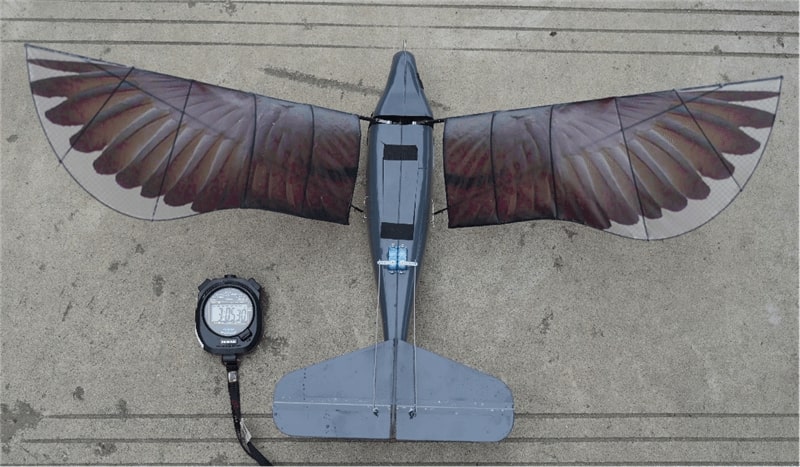Chinese researchers from the Northwestern Polytechnical University (NPU) have developed a ‘flapping wing’ bird drone, celebrated in the country as a significant scientific achievement.
The drone also broke its previous Guinness World Record in the flight time. Also known as a ‘bionic drone,’ the UAVs are based on mechanics that replicate the intricate flying mechanism of real birds, becoming part of a global technological pursuit by various other developers.
Called ‘Xinge,’ the drone broke the flight duration record of its predecessor by nearly one-and-a-half hours, which the NPU has hailed as a “technological leap.” The EurAsian Times had previously reported how a New Mexico Institute of Technology (NMIT) team had built and flown drones using genuine bird parts from deceased and taxidermied birds.
Other universities elsewhere in the world have developed such bionic drones. Still, the Chinese product has explicitly been advertised to have diverse applications in various “environments,” suggesting a military role.
Beijing already has a varied arsenal of UAVs and unmanned systems. A flying object that travels through the air like a bird would be even harder to detect.
Remote-Controlled Robot Birds
According to a report in the China Global Television Network (CGTN), the “independent” project by the NPU led to the development of the “ornithopter homing pigeon” Yunxiao and an advanced, improved version, the Xinge.
“The ornithopter Xinge, or the homing pigeon, can fly for up to three hours, five minutes, and 30 seconds continuously in one charge, breaking the previous Guinness World Record created by the team,” the report said.
The team’s previous development was the Yunxiao, which flew for 2 hours, 34 minutes and 38 seconds. Xinge has a wingspan of 70 centimeters and weighs 260 grams. Compared to its predecessor, Yunxiao, the body of Xinge is more petite, with more than half of Yunxiao’s wingspan and one-quarter of its weight.
“It’s a leap in technological advance of the bionic aircraft. The significant increase in fly time not only verifies the aircraft’s performance but helps expand its application possibilities, which will speed up its use in reality,” the university’s chief scientist Song Bifeng quoted in the CGTN report.

Possible Military Use
Subsequent information about the drone’s physical attributes and possible usage areas in the CGTN report suggested a military or security role alongside other primary functions. “The bionic flapping-wing aircraft imitates the flight mode of birds and other creatures flapping their wings. It is lightweight, small in size, and low noise, as well as is bionic, concealable, and portable.
“It is easily used for hand-thrown take-off and gliding to land, which can be used in many situations such as covert reconnaissance in a complex environment, emergency rescue, and field biological scientific research,” the report added.
With tensions with India permanently high, when operational, the bird drone might be used for tactical surveillance of ground positions. It can be employed in Ladakh, in freezing high-altitude Himalayan deserts, or in Arunachal Pradesh, over the dense tropical forestry.
But the report also clarifies the “independent” nature of the project, meaning the PLA had not specifically approached the NPU to develop the drone or has even conceptualized using bird-like drones in its inventory. However, once the system is matured and refined, the Chinese military might develop some interest and order a few batches for testing.
Moreover, in Arunachal Pradesh, China has been suspected of using actual pigeons with Mandarin-scripted messages wound around their feet, suggesting a non-electronic communication link between its spies and handlers. Villagers in the Lohit Valley of Arunachal’s Anjaw district had caught some birds with Chinese tags in May 2017.
Can Have Other Uses Too
Indeed, it is clear that the drones however have not been developed for purely defense purposes. Those uses might require developing other variants with a different or modified set of electrical, mechanical, and electronic components.
China also has a large domestic civilian market and has several biodiversity and conservation hotspots where such bird drones can be employed.

“The research team has used their bird-like drone to fly for over 1,500 flight missions in over ten cities and regions to test out and improve their design and technology in different environments,” the report added.
Thus, the drones are clearly in a testing phase and can be expected not to be operationalized soon, with a series of more trials before they are exhibited before end-users enter mass production.
PLA Links Of Drone Developer
Another reason the bird drones are likely to have a military purpose is the affiliation of the NPU with the People’s Liberation Army (PLA) and China’s defense State Owned Enterprises (SOE).
It is a part of the Seven Sons of National Defense, a group of universities and higher-technical institutions supported in a decades-long program to make China self-reliant in defense manufacturing.
A 2020 report by the Center for Security and Emerging Technology (CSET) that tracked the Seven Sons’ links to China’s military apparatus said the NPU contributed 963 graduates as employees with the SOEs in 2019, the highest among all other universities.
- The author can be reached at satamp@gmail.com
- Follow EurAsian Times on Google News




